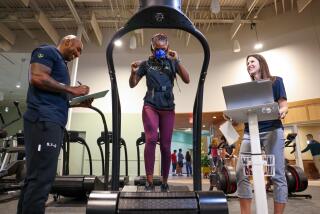Planning Can Do Wonders for the Health of Fitness, Wellness Sessions
- Share via
You have been invited to plan a session on health, physical fitness or wellness as part of an educational program. The organization sponsoring the program recognizes that these topics are important to their membership. They know that increasing their membership’s fitness consciousness can help increase productivity, improve quality of life and cut down on the cost of health care.
The support of top management is important. Such companies as Tenneco Inc. point out that executives and employees practice good health and fitness habits when they realize health is important to management. Don Kendall, former head of Pepsico, for example, exercised every day near his office in Westchester County, N.Y. Other executives and personnel were thereby motivated.
As part of the pre-planning for a meeting, it is important to determine the goals and objectives one hopes to accomplish. The initial goal should be to develop awareness and change behavior so that life styles include sound health practices.
Lauve Metcalfe, director of health and fitness programming for Campbell Soup’s Institute for Health says, “Awareness means that people understand that the way to enhance their health and fitness is through choices, i.e., to become aware of the need to select healthy versus destructive choices.”
How can we make people aware of the need for healthy choices and life style? The methods used should be geared to the needs and interests of the audience. Presentations should relate to them personally. In order to do this, some organizations prepare a brief questionnaire to be completed by people planning to attending the meeting.
Sample questions reveal what each individual is doing to be physically fit:
- When participating in fitness, what is the duration of your participation? (1) Less than 10 minutes; (2) Between 10 and 30 minutes; (3) More than 30 minutes.
- How would you classify your flexibility? (1) Poor; (2) Adequate; (3) Good; (4) Very good.
Some organizations use such instruments as a “health risk appraisal,” a questionnaire designed to provide a group profile. One appraisal form, developed by the Public Health Service, is designed to determine what a person is doing to stay healthy. It covers such factors as cigarette smoking, alcohol and drugs, eating habits, exercise, stress control and safety.
Participants score themselves numerically. There are also sections on “what your score means to you” and what can be done to get a better score.
There are many such inventories, tests and instruments that can be completed in a few moments and will help to identify some of the health risk factors of the group being targeted.
Using a questionnaire, health risk appraisal or other instrument helps participants become aware of their own health and fitness and provides valuable information for program planning.
In addition to the questionnaire technique, a discussion of pertinent topics in the news, such as cholesterol or weight control, might also be valuable. The idea is to arouse curiosity and make people aware that they have a responsibility to something about their own health and fitness.
Meeting planners interested in health and fitness should also survey the resources that are available at the conference or meeting site. Some hotels have excellent fitness rooms, outdoor tracks and swimming pools that are available to those attending a conference. This should be publicized. It probably would also be wise to plan for the efficient use of professionals and volunteers to carry out the program.
Some activities that meeting planners have found successful are:
- 5-kilometer or 2-mile runs or run-walks (early morning, lunchtime, early evenings).
- Fitness breaks in which the audience becomes participants performing various physical exercises.
- Simple ways to estimate body fat.
- Tests: blood pressure, weight, etc.
- Diet analyzer, in relation to nutritional requirements.
- Hands-on learning sessions. Instead of talking about stretching, have stretching breaks.
- Movies, films, cassettes on selected health, fitness and wellness topics.
- Mini-sessions on such topics as smoking cessation, weight control, stress management, aerobics and nutrition (based on needs and interest surveys).
These mini-sessions should be organized and planned so participants go away with information they can incorporate into their own life styles.


